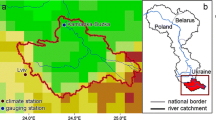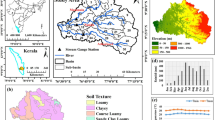Abstract
The Ogallala or High Plains aquifer provides water for about 20% of the irrigated land in the United States. About 20 km3 (16.6 million acre-feet) of water are withdrawn annually from this aquifer. In general, recharge has not compensated for withdrawals since major irrigation development began in this region in the 1940s. The mining of the Ogallala has been pictured as an analogue to climate change in that many GCMs predict a warmer and drier future for this region. In this paper we attempt to anticipate the possible impacts of climate change on the sustainability of the aquifer as a source of water for irrigation and other purposes in the region. We have applied HUMUS, the Hydrologic Unit Model of the U.S. to the Missouri and Arkansas-White-Red water resource regions that overlie the Ogallala. We have imposed three general circulation model (GISS, UKTR and BMRC) projections of future climate change on this region and simulated the changes that may be induced in water yields (runoff plus lateral flow) and ground water recharge. Each GCM was applied to HUMUS at three levels of global mean temperature (GMT) to represent increasing severity of climate change (a surrogate for time). HUMUS was also run at three levels of atmospheric CO2 concentration (hereafter denoted by [CO2]) in order to estimate the impacts of direct CO2 effects on photosynthesis and evapotranspiration. Since the UKTR and GISS GCMs project increased precipitation in the Missouri basin, water yields increase there. The BMRC GCM predicts sharply decreased precipitation and, hence, reduced water yields. Precipitation reductions are even greater in the Arkansas basin under BMRC as are the consequent water yield losses. GISS and UKTR climates lead to only moderate yield losses in the Arkansas. CO2-fertilization reverses these losses and yields increase slightly. CO2 fertilization increases recharge in the base (no climate change) case in both basins. Recharge is reduced under all three GCMs and severities of climate change.
Similar content being viewed by others
References
Arnold, J. G., Allen, P. M., and Bernhardt, G.: 1993, ‘A Comprehensive Surface-Groundwater Flow Model’, J. Hydrol. 142, 47–69.
Arnold, J. G. and Allen, P. M.: 1996, ‘Estimating Hydrologic Budgets for Three Illinois Watersheds’, J. Hydrol. 176, 57–77.
Arnold, J. G., Williams, J. R., Srinivasan, R., and King, K. W.: 1996, SWAT. Soil Water Assessment Tool, Report of USDA/Agricultural Research Service and the Texas Agricultural Experiment Station, Blacklands Research Center, Temple, TX.
Arnold, J. G., Srinivasan, R., Muttiah, R. S., and Williams, J. R.: 1998a, ‘Large Area Hydrologic Modeling and Assessment. Part I: Model Development’, J. Amer. Water Resour. Assoc. 34: 1–17.
Arnold, J. G., Srinivasan, R., Muttiah, R. S., and Allen, P. M.: 1998b, Continental Scale Simulation of the Hydrologic Balance, BRC Report 98–03, Texas Agricultural Experiment Station, Texas A&M University System, Temple, TX, J. Amer. Water Resour. Assoc., submitted.
Brown, R. A. and Rosenberg, N. J.: 1997, ‘Sensitivity of Crop Yield and Water Use to Change in a Range of Climatic Factors and CO2 Concentrations: A Simulation Study Applying EPIC to the Central U.S.A.’, Agric. For. Meteorol. 83, 171–203.
Dugan, J. T. and Sharpe, J. B.: 1996, Water-Level Changes in the High Plains Aquifer — Predevelopment to 1994, U.S. Geological Survey, Water-Resources Investigations Report 95–4208.
Edmonds, J.A., Pitcher, H. M., Rosenberg, N. J., and Wigley, T. M. L.: 1994, Design For the Global Change Assessment Model, Proceedings of the International Workshop on Integrative Assessment of Mitigation, Impacts and Adaptation to Climate Change 13–15 October 1993, Laxenburg, Austria.
Edmonds, J. A., Pitcher, H. M., Barns, D., Baron, R., and Wise, M. A.: 1995, ‘Modeling Future Greenhouse Gas Emissions: The Second Generation Model Description’, in Modelling Global Change, United Nations University Press, Tokyo, Japan.
Frederick, K. D.: 1993, ‘Climate Change Impacts on Water Resources and Possible Responses in the MINK Region’, Paper 4, in Rosenberg, N. J. (ed.), Towards an Integrated Impact Assessment of Climate Change: The MINK Study, Climatic Change 24, Kluwer Academic Publishers, Dordrecht, pp. 83–115.
Glantz, M.H. and Ausubel, J. H.: 1988, ‘Impact Assessment by Analogy: Comparing the Impacts of the Ogallala Aquifer Depletion and CO2-Induced Climate Change’, in Glantz, M. H. (ed.), Societal Responses to Regional Climatic Change, Chapter 6, Westview Press, Boulder, CO, pp. 113–142.
Graczyk, D.J., Krug, W. R., and Gebert, W. A.: 1986, A History of Annual Streamflows from the 21 Water-Resource Regions in the United States and Puerto Rico, 1951–83, USGS Open File Report 86–126.
Hansen, J., Lacis, A., Rind, D., Russell, L., Stone, P., Fung, I., Ruedy, R., and Lerner, J.: 1984, ‘Climate Sensitivity Analysis of Feedback Mechanisms’, in Hansen, J. and Takahashi, T. (eds.), Climate Processes and Climate Sensitivity, Geophysical Monograph, American Geophysical Union, Washington, DC, pp. 130–163.
Houghton, J. T., Meira Filho, L. G., Callander, B. A., Harris, N., Kattenberg, A., and Maskell, K. (eds.): 1996, Climate Change 1995: The Science of Climate Change, Second Assessment Report of the Intergovernmental Panel on Climate Change, Working Group I, Cambridge University Press, Cambridge.
Hulme, M., Jiang, T., and Wigley, T. M. L.: 1995, SCENGEN, A Climate Change Scenario Generator: A User Manual, Climatic Research Unit, Univ. of East Anglia, Norwich, U.K., p. 38.
Hurd, B. H., Callaway, J. M., Smith, J. B., and Kirshen, P.: 1999, ‘Economic Effects of Climate change on U.S. Water Resources’, in Mendelsohn, R. and Neumann, J. E. (eds.), Cambridge University Press, Cambridge, in press.
Kimball, B. A.: 1983, ‘Carbon Dioxide and Agricultural Yield: An Assemblage and Analysis of 770 Prior Observations’, Agronomy J. 75, 779–788.
Kimball, B. A., Rosenberg, N. J., and Allen Jr., L. H. (eds.): 1990, 'Impacts of Carbon Dioxide, Trace Gases and Climate Change on Global Agriculture, American Society of Agronomy, Special Publication 53, 1–133.
Langbein, W. B., et al.: 1949, Annual Runoff in the United States, U.S. Geological Survey Circular 5, U.S. Department of the Interior, Washington, DC.
Lettenmaier, D. and Wood, E.: 1994, Implementation of the VIC-2L Land and Surface Scheme to Model the Hydrology of Large Continental Rivers, Report to the Electric Power Research Institute, Palo Alto, CA.
McAveney, B. J., Colman, R., Fraser, J. F., and Dhani, R. R.: 1991, The Response of the BMRC AGCM to a Doubling of CO 2 , BMRC Technical Memorandum No. 3, Melbourne, Australia.
Milly, P. C. D.: 1994, ‘Climate Soil Water Storage and the Average Annual Water Balance’, Water Resour. Res. 30, 2143–2156.
Monteith, J. L.: 1963, ‘Gas Exchange in Plant Communities’, in Evans, L. T. (ed.), Environmental Control of Plant Growth, Academic Press, New York, pp. 95–112.
Murphy, J. M.: 1995, ‘Transient Response of the Hadley Centre Coupled Ocean-Atmosphere Model to Increasing Carbon Dioxide, Part I, Control Climate and Flux Correction’, J. Climate 8, 35–56.
Revelle, R. R. and Waggoner, P. E.: 1983, ‘Effects of a Carbon-Dioxide-Induced Climatic Change on Water Supplies in the Western United States’, in Changing Climate, National Academy of Sciences, National Academy Press, Washington, DC, pp. 419–432.
Richardson, C. W. and Nicks, A. D.: 1990, ‘Weather Generator Description’, in Sharpley, A. N. and Williams, J. R. (eds.), EPIC — Erosion Productivity Impact Calculator: 1. Model Documentation, U.S. Department of Agriculture Technical Bulletin No. 1768.
Rosenberg, N. J., Kimball, B. A., Martin, Ph., and Cooper, C. F.: 1990, ‘Climate Change, CO2 Enrichment and Evapotranspiration’, in Waggoner, P. E. (ed.), Climate Change and U.S. Water Resources, Wiley Interscience, New York, pp. 151–175.
Rosenberg, N. J., McKenney, M. S., and Martin, Ph.: 1989, ‘Evapotranspiration in a Greenhouse Warmed World, a Review and a Simulation’, Agric. For. Meteorol. 47, 303–320.
Schaake, J. C.: 1990, ‘From Climate to Flow’, Chapter 8, in Waggoner, P. E. (ed.), Climate Change and U.S. Water Resources, Wiley Interscience, New York, pp. 177–206.
Srinivasan, R., Arnold, J. G., Muttiah, R. S., Walker C., and Dyke, P. T.: 1993, ‘Hydrologic Unit Model for the United States (HUMUS)’, in Proceedings of Advances in Hydro-science and Engineering, CCHE, School of Engineering, University of Mississippi, Oxford, MS.
Stockle, C. O., Williams, J. R., Rosenberg, N. J., and Jones, C. A.: 1992a, ‘A Method for Estimating Direct and Climatic Effects of Rising Atmospheric Carbon Dioxide on Growth and Yield of Crops: Part I — Modification of the EPIC Model for Climate Change Analysis’, Agricultural Systems 38, 225–238.
Stockle, C.O., Dyke, P. T., Williams, J. R., Jones, C. A., and Rosenberg, N. J.: 1992b, ‘A Method for Estimating Direct and Climatic Effects of Rising Atmospheric Carbon Dioxide on Growth and Yield of Crops: Part II — Sensitivity Analysis at Three Sites in the Midwestern U.S.A.’, Agricultural Systems 38, 239–256.
Stockton, C. W. and Boggess, W. R.: 1979, Geohydrological Implications of Climate Change on Water Resource Development, U.S. Army Coastal Engineering Research Center, Fort Belvoir, VA.
United States Geological Survey: 1987, Hydrologic Unit Maps, USGS Water-Supply Paper 2294, U.S. Government Printing Office, Washington, DC.
Wigley, T. M. L.: 1994, MAGICC Version 1.2: User's Guide and Scientific Reference Manual, NCAR, Boulder, CO, p. 23.
Rights and permissions
About this article
Cite this article
Rosenberg, N.J., Epstein, D.J., Wang, D. et al. Possible Impacts of Global Warming on the Hydrology of the Ogallala Aquifer Region. Climatic Change 42, 677–692 (1999). https://doi.org/10.1023/A:1005424003553
Issue Date:
DOI: https://doi.org/10.1023/A:1005424003553




